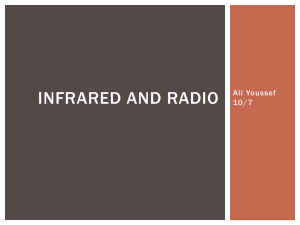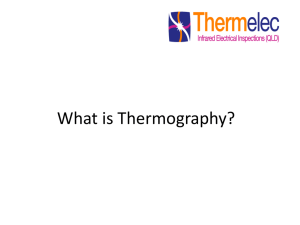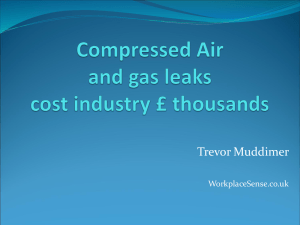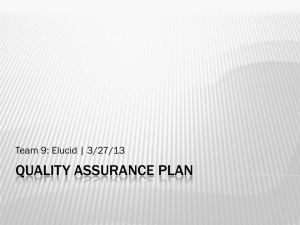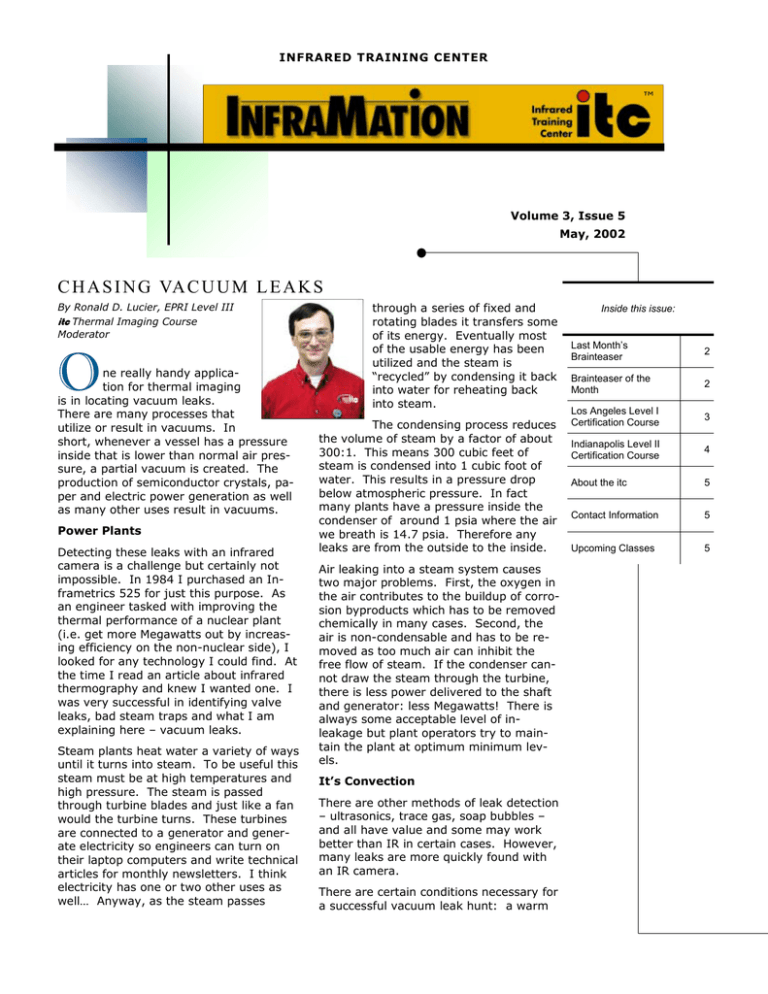
INFRARED TRAINING CENTER
™
Volume 3, Issue 5
May, 2002
C H A S I N G VA C U U M L E A K S
By Ronald D. Lucier, EPRI Level III
itc Thermal Imaging Course
Moderator
O
ne really handy application for thermal imaging
is in locating vacuum leaks.
There are many processes that
utilize or result in vacuums. In
short, whenever a vessel has a pressure
inside that is lower than normal air pressure, a partial vacuum is created. The
production of semiconductor crystals, paper and electric power generation as well
as many other uses result in vacuums.
Power Plants
Detecting these leaks with an infrared
camera is a challenge but certainly not
impossible. In 1984 I purchased an Inframetrics 525 for just this purpose. As
an engineer tasked with improving the
thermal performance of a nuclear plant
(i.e. get more Megawatts out by increasing efficiency on the non-nuclear side), I
looked for any technology I could find. At
the time I read an article about infrared
thermography and knew I wanted one. I
was very successful in identifying valve
leaks, bad steam traps and what I am
explaining here – vacuum leaks.
Steam plants heat water a variety of ways
until it turns into steam. To be useful this
steam must be at high temperatures and
high pressure. The steam is passed
through turbine blades and just like a fan
would the turbine turns. These turbines
are connected to a generator and generate electricity so engineers can turn on
their laptop computers and write technical
articles for monthly newsletters. I think
electricity has one or two other uses as
well… Anyway, as the steam passes
through a series of fixed and
rotating blades it transfers some
of its energy. Eventually most
of the usable energy has been
utilized and the steam is
“recycled” by condensing it back
into water for reheating back
into steam.
The condensing process reduces
the volume of steam by a factor of about
300:1. This means 300 cubic feet of
steam is condensed into 1 cubic foot of
water. This results in a pressure drop
below atmospheric pressure. In fact
many plants have a pressure inside the
condenser of around 1 psia where the air
we breath is 14.7 psia. Therefore any
leaks are from the outside to the inside.
Air leaking into a steam system causes
two major problems. First, the oxygen in
the air contributes to the buildup of corrosion byproducts which has to be removed
chemically in many cases. Second, the
air is non-condensable and has to be removed as too much air can inhibit the
free flow of steam. If the condenser cannot draw the steam through the turbine,
there is less power delivered to the shaft
and generator: less Megawatts! There is
always some acceptable level of inleakage but plant operators try to maintain the plant at optimum minimum levels.
It’s Convection
There are other methods of leak detection
– ultrasonics, trace gas, soap bubbles –
and all have value and some may work
better than IR in certain cases. However,
many leaks are more quickly found with
an IR camera.
There are certain conditions necessary for
a successful vacuum leak hunt: a warm
Inside this issue:
Last Month’s
Brainteaser
2
Brainteaser of the
Month
2
Los Angeles Level I
Certification Course
3
Indianapolis Level II
Certification Course
4
About the itc
5
Contact Information
5
Upcoming Classes
5
VOLUME 3, ISSUE 5
LEAKS (CONTD.)
(Continued from page 1)
surface of high emissivity, a system
under vacuum, at least one other
method to confirm the leak (I like
ultrasonics) and a patient and very
thorough thermographer.
INFRARED TRAINING CENTER
PAGE 2
stems & packing stuffers, turbine shell, rupture diaphragms,
instrument line fittings and
other mechanical joints, literally
thousands of possible locations
within a small plant.
159.9°F
150
140
Examples
130
In power plants we look for
Convection heat transfer is very
120
leaks above the water level and
complicated as everyone knows.
below. In general those above
114.7°F
However, in the case of vacuum
the water level are large and
leaks its complexity helps us. We
Figure 3. The leaking bolt in this vacuum pump is
easily detected by ultrasonics
show in our training classes that air
easy to spot
and trace gas technology. Figflow affects heated surfaces. This
ure 1 shows
is what you look
Conclusion
a flange at the
189.3°F
for when hunting
neck of the convacuum leaks.
The examples shown above should
denser between
Small changes in
be confirmed with another technola steam driven
180
air flow across a
ogy before any maintenance is
pump and the
surface cause
planned. Occasionally there is a
condenser.
small changes in
reason the bolts look different –
170
There is a 14 ºF
the surface temusually due to emissivity differdifference beperature. Many
ences. All of the above are probatween the bolt
160
times this tembly large leaks. The smaller leaks
that is the source
perature change
may indicate an 0.1 ºF temperature
of the leak and
154.3°F
is rapid and
difference and usually are best obbolts not leaking.
looking at susserved and diagnosed as live,
Figure 1. Flange at neck of condenser showing This bolt was
pected locations vacuum leak
rather than static images. Good
loose and the air
we can see the
Hunting!!
was being
surface changing temperature.
sucked past the bolt threads.
Other times the leak is large
enough that the temperature doesAn example from below the water
n’t change, as in the bolt in the
level is shown in Figure 2. Such
condenser picture.
leaks are harder to find with trace
41.5°C
gas technology but ultrasonics
In all cases IR can produce some
40
works well.
false positives so rely on at least
one other confirming test method
41.2° C
35
before taking any corrective ac30
tions.
40
BRAINTEASER
OF THE MONTH
What Leaks Where?
25
There are many locations that can
produce a vacuum leak. These include flanges, access covers, valve
38
20
36
35.6° C
LAST MONTH’S
BRAINTEASER
N
obody was even close on
April’s Brainteaser. But
that’s okay, it
was a hard
one. The hot
spot is a fly
resting on the
wall.!
Figure 2. Another leak that shows up well in
IR but is harder to find with tracer gas techniques
Vacuum Pumps
Common in many industries are
vacuum pumps. The pump in Figure 3 is one of many drawing a
vacuum used in the papermaking
process. In this case the bolt that is
leaking is very evident.
H
15.5°C
ere is this
month’s
brainteaser. First
reader to email me
with the correct
explanation wins $20
in Infrabucks. Please
put “Brainteaser” as the subject of
the message.!
Mailto:
Gary.Orlove@infraredtraining.com
Infrared Thermography
Level I certification course
The Infrared Training Center is holding a series of infrared training courses
and would like to invite you to attend!
The Level I course is geared to the new IR camera user and focuses on its
use for a variety of applications.
Attendees completing course requirements and a field assignment will
receive a Level I Thermography Certification.
COURSE HIGHLIGHTS
• Introduction to thermal imaging and measurement systems for predictive maintenance
applications. No experience in thermography is necessary!
• Collect quality data, accurate temperature readings, and account for measurement effects
such as distance and emissivity using IR cameras.
• Interpret thermograms and make informed decisions using heat transfer concepts to
analyze images, and see the latest in report generation and database software.
• Avoid costly mistakes — distinguish between hot spots and reflections, direct vs. indirect
readings and qualitative vs. quantitative thermography.
TUITION
A registration fee of $1550 includes 4-day seminar cost, breakfast/lunch and all course materials.
TIME & PLACE
DATE:
TIME:
WHERE:
May 20-23, 2002
7 A.M. TO 3:30 P.M.
Los Angeles Dept. of Water & Power
11781 Truesdale St.
Sun Valley, CA 91352
(213) 367-7046 Contact: Louise
Hotels in the area are:
Ramada Inn, 2900 N. San Fernando Blvd.
Burbank, CA phone: (818) 843-3463
Rate: $78.40 + Tax (Ask for Natalia)
Hilton, 2500 N. Hollywood Way
Burbank, CA phone: (818) 843-6000
Rate: $144 + Tax
REGISTRATION
If you have any questions or to confirm registration, please contact Laurie Kelley:
(978) 901-8291 or toll free at 1-866 TRAINIR.
1-866 TRAINIR
www.infraredtraining.com
Infrared Thermography
Level II certification course
The Infrared Training Center is holding a series of infrared training courses
and would like to invite you to attend!
The Level II course is geared to the new IR camera user and focuses on its
use for a variety of applications.
Attendees completing course requirements and a field assignment will
receive a Level II Thermography Certification.
COURSE HIGHLIGHTS
• Introduction to thermal imaging and measurement systems for predictive maintenance
applications. No experience in thermography is necessary!
• Collect quality data, accurate temperature readings, and account for measurement effects
such as distance and emissivity using IR cameras.
• Interpret thermograms and make informed decisions using heat transfer concepts to
analyze images, and see the latest in report generation and database software.
• Avoid costly mistakes — distinguish between hot spots and reflections, direct vs. indirect
readings and qualitative vs. quantitative thermography.
TUITION
A registration fee of $1550 includes 4-day seminar cost, breakfast/lunch and all course materials.
TIME & PLACE
DATE:
TIME:
WHERE:
June 10-13, 2002
8 A.M. TO 5 P.M.
Days Inn Airport Indianapolis
5860 Fortune Circle Drive - West
Indianapolis, IN 46241
CONTACT: 317-248-0621
The Days Inn Airport offers shuttle service to and from
the International
airport. Shuttle begins each morning 4:00 a.m. 12:00 midnight. The Days
Inn is located 1/2 mile from the International Airport.
ROOMS:
FLIR Systems Room Rate: $58.00 + tax
Hotel info: http://www.the.daysinn.com/indianapolis05568/hotelhome/?sid=AAAksrACwAAABrfAAL
REGISTRATION
If you have any questions or to confirm registration, please contact Laurie Kelley:
(978) 901-8291 or toll free at 1-866 TRAINIR.
1-866 TRAINIR
www.infraredtraining.com
itc U.S.A., BOSTON
itc INTERNATIONAL, SWEDEN
16 Esquire Road
N. Billerica, MA 01862, USA
Rinkebyvägen 19
SE-182 11 Danderyd, Sweden
Tel: +1-978-901-8405
Toll free: +1-866-TRAINIR
(866-872-4647)
Fax: +1.978.901-8832
E-mail:
mailto:info_us@infraredtraining.com
Tel: +46 (0) 8 753 25 00
Fax: +46 (0) 8 753 26 01
E-mail: mailto:itc@flir.se
“Delivering world-class training and knowledge about thermography”
About the Infrared Training Center
The Infrared Training Center offers training and
certification in all aspects of infrared thermography use. Our world-class training facilities are
located near Boston, Massachusetts, USA and
Stockholm, Sweden and have the world's most
extensive hands on laboratories for infrared applications. Please join us in exploring the fascinating world of infrared!
Your comments and suggestions about this newsletter are welcomed and encouraged. If you have
an interesting application or case study to share,
we encourage you to submit it for publication.
Please e-mail
mailto:Gary.Orlove@infraredtraining.com or
regular mail to the USA office
itc INFRAMATION - Editor / Designer: Gary Orlove
Upcoming Classes - Americas
Remember we also teach customer site training courses at your convenience. Please contact us for more information.
May 2002
• 4/29-3 – Level I – Boston, MA
• 7-10 – Level III – Boston, MA
• 20-23 - Level I Montreal, Canada
• 20-23 - Level I - Los Angeles, CA
• 21-24 – Level I – Lake Charles, LA
• 27-31 – Level I – Brazil
June 2002
• 3-6 - Level II - Miami, FL
• 3-7 – Level I – Boston, MA
• 10-14 – Level II – Boston, MA
• 10-13 – Level II – Indianapolis, IN
• 18-21 - Level I - Puerto Rico
• 24-27 – Level I – Las Vegas, NV
• 24-28 - Level I - Trinidad
July 2002
• 15-19 – Level I – Boston, MA
• 15-18 – Level I – Portland, OR
• 15-19 – Level I – Venezuela
• 22-25 – Level I – Nashville, TN
• 29-8/1 – Level I – Detroit, MI
August 2002
• 5-9 – Level I – Boston, MA
• 6-9 – Level I – Chicago, IL
• 6-9 – Level I – Denver, CO
• 12-15 – Level II – Chicago, IL
• 13-16 – Level I – San Francisco, CA
• 26-29 - Level I - Honolulu, HI
Upcoming Classes - International
May 2002
• 13-17 - Level I - Indonesia
• 20-24 - Level I - Japan
June 2002
• 3-7 - Level I
• 10-14 - Level II - South Africa
• 17-21 - Level II - UK
• 24-28 - Level I
July 2002
• 1-5 - Level I - Italy
• 1-5 - Level I - South Africa (ABB)
August 2002
• No Courses
Upcoming Classes - Germany
Rent an infrared camera from FLIR Systems to locate electrical and mechanical
problems, schedule repairs, and avoid costly plant shutdowns. Whether you have a
temporary testing/inspection requirement or need to evaluate an IR camera before
purchasing, renting from FLIR can help you solve problems.
# Rent direct from the world
leading IR camera manufacturer
# Low rates and quick delivery
# Build credit toward purchase
# Wide selection of camera
technologies and accessories
For more information
call us toll free at
1 (866) IR RENTS
1 (866) 477 3687
http://www.infraredcamerarentals.flir.com
May 2002
• 14-16 - Operator CM
• 14-16 - Level I EN 473 (part 1)
• 22-24 - Level I EN 473 (part 2)
June 2002
• 24-26 - Operator CM
• 24-29 - Level I EN 473
July 2002
• 9-11 - R&D
• 22-24 - Operator CM
• 22-27 - Level I EN 473
Upcoming Classes - France
May 2002
• 27-29 - Operator CM
June 2002
• 10-12 - Operator CM
August 2002
• No Courses
©2002 infrared training center - All rights reserved

